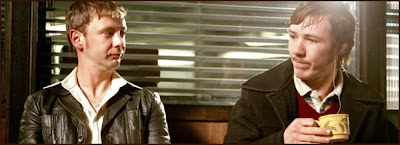Prepare by writing notes for this essay question.
In what ways is Life on Mars a post modern TV drama?
You can watch the first part of the episode again by clicking this link
Find the others so you can fill out your notes further.
Pick up the final intertextual references and contrasts between the reality of 1973 and 2006 in this last part of the episode. Use the info. below to help you make notes and points. ( The 1968 film, The Good, The Bad and Ugly and the 1939 film, The Wizard of Oz. Why are these references there? What meanings do they add to "Life On Mars" or it characters?)
CLICK HERE for the link to the end of this episode.
You can watch the first part of the episode again by clicking this link
Find the others so you can fill out your notes further.
Pick up the final intertextual references and contrasts between the reality of 1973 and 2006 in this last part of the episode. Use the info. below to help you make notes and points. ( The 1968 film, The Good, The Bad and Ugly and the 1939 film, The Wizard of Oz. Why are these references there? What meanings do they add to "Life On Mars" or it characters?)
CLICK HERE for the link to the end of this episode.
Essay Task: how do audiences react to this post modern TV drama?
As you watch the second episode of Life On Mars (2006) pause sometimes so you can write notes on the following points:
How is reality represented?
1. What is real and what is hyperreal? How does the programme suggest Sam Tyler may be dreaming up the early 1970s while in a coma from his hospital bed? How does the programme show that this may just be an immersive dream?
2. Intertextuality – Can you identify references to other texts/programmes/music from the past: the 1970s buddy cop shows, The Sweeney (UK) and Starsky and Hutch (USA). When you spot or hear an intertextual or cultural reference try to explain how to adds meaning to your text.
3. The historical context - How the programme’ meaning(s) for our time comes out of being set in the past. Consider the issues of Sam Tyler’s identity and his political correctness from 2006 and how this clashes in particular with Gene Hunt. Consider also how Sam's ethics and police methods clash with Gene Hunt's: a scientific approach verses instinct.
How does the programme consciously show politically incorrect behaviour and attitudes for audiences to judge them in our time:
• racism
• sexism including the treatment of women
• homophobia and masculinity
• inappropriate language/terms
• smoking
• drinking
• swearing
• references to people from our time ( in some episodes)
• ideology ( out of place beliefs )
• violence
• driving
• police behaviour and other inappropriate behaviour
• your ideas
4. How useful are technical forms of representation for understanding this “text” as postmodern? (Camerawork, mise-en-scene, editing, lighting, etc.) For example, Gene Hunt’s POV shot of the female witness with the close up of her chest.
Here is just ONE of the intertextual links that you might easily miss. The main villain, Kim Trent, triumphantly whistles "Quinn The Eskimo (The Mighty Quinn)" (1967) as he leaves the police station. Listen to the song's lyrics and consider why. Identify other intertextual references and think about the meaning(s) that they add to the episode.


No comments:
Post a Comment